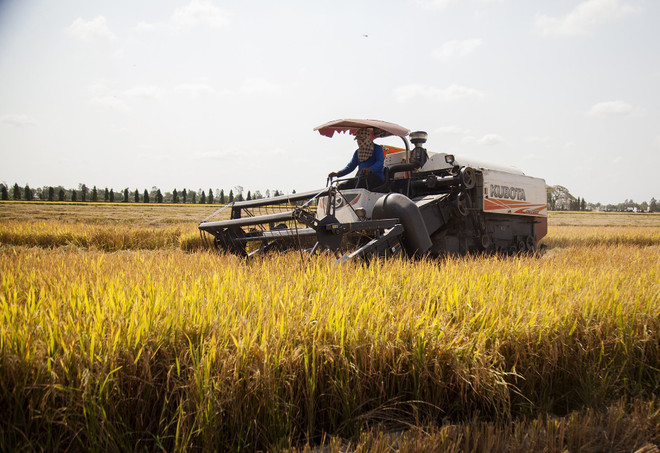 Winter-spring rice is harvested in Tan An commune of Tan Hiep district, the Mekong Delta province of Kien Giang (Photo: VNA)
Winter-spring rice is harvested in Tan An commune of Tan Hiep district, the Mekong Delta province of Kien Giang (Photo: VNA)Hanoi (VNA) – Vietnam is enjoyingstrong growth in both rice export volume and value, and more export chances arestill ahead as some free trade agreements (FTAs) have come into force andconsumers around the globe are boosting purchase to ensure food security amidthe COVID-19 outbreak.
In the first two months of 2020, about 900,000tonnes of rice worth 410 million USD were shipped abroad, up 27 percent involume and 32 percent in value year on year, according to the Ministry ofAgriculture and Rural Development (MARD).
Export prices averaged 478 USD per tonne inJanuary, rising 7 percent from the same period last year. The Philippines wasthe biggest importer, accounting for 31 percent of total rice shipments.Meanwhile, Mozambique and Angola were among the markets with biggest growthrates.
Phan Xuan Que, General Director of the VietnamNorthern Food Corporation (VINAFOOD 1), said after the Lunar New Year holidayin late January, the rice market has been very vibrant. Prices set for bothexport and domestic sale surged by 30 – 50 USD per tonne, depending onvarieties and quality.
He noted rice prices are usually adjusted on thequarterly or yearly basis, but they have been changed week by week in the firstmonths of this year, which is a very rare situation, especially when the MekongDelta – the country’s largest agricultural production hub – is currently in theharvest period of the winter-spring crop.
These positive signs show Vietnam is likely toachieve the rice export target of 6.7 million tonnes worth over 3 billion USDthis year, according to him.
Explaining the reason for good prices in allsegments, Que said as countries opened their markets for rice imports early,businesses have inked big contracts and stepped up purchase of inputs. Besides,China, which previously dominated the African market with about 3 milliontonnes of rice annually, has been affected by the COVID-19 outbreak, creating achance for Vietnamese rice in this market.
Strong demand from the Philippines and Malaysiahas also helped raise prices of Vietnamese rice, thus helping the grain tonarrow the price gap with the Thai counterpart and surpass the Myanmar andIndian rivals.
The MARD’s Agro Processing and MarketDevelopment Authority said demand for Thai rice stays flat as drought in thiscountry has driven concerns about supply sources.
Export prices of Vietnamese rice are likely to risefurther since they are still much lower than those of other producers’ rice,the authority noted, adding that global consumers are boosting purchase whileChina doesn’t increase its shipments in order to ensure food security to copewith the COVID-19 epidemic.
Que attributed the rosy export signs partly tothe agricultural restructuring, which in turn has helped restructure exportmarkets to reduce dependence on certain markets. Moreover, the competitivenessof Vietnamese rice, including that of components in the rice value chain fromproduction, supply, processing and transportation, has been improved.
However, he said the agricultural sectors aswell as businesses should continue to keep a close watch on changes in themarket to concurrently attain food security and export targets.
According to the MARD, the COVID-19 outbreak haslittle impact on Vietnam’s rice sector, and there are likely more opportunitiesfor export to East Africa. Besides, companies should also gear up to capitaliseon advantages generated the FTA between the EU and Vietnam when this deal takeseffect./.





























